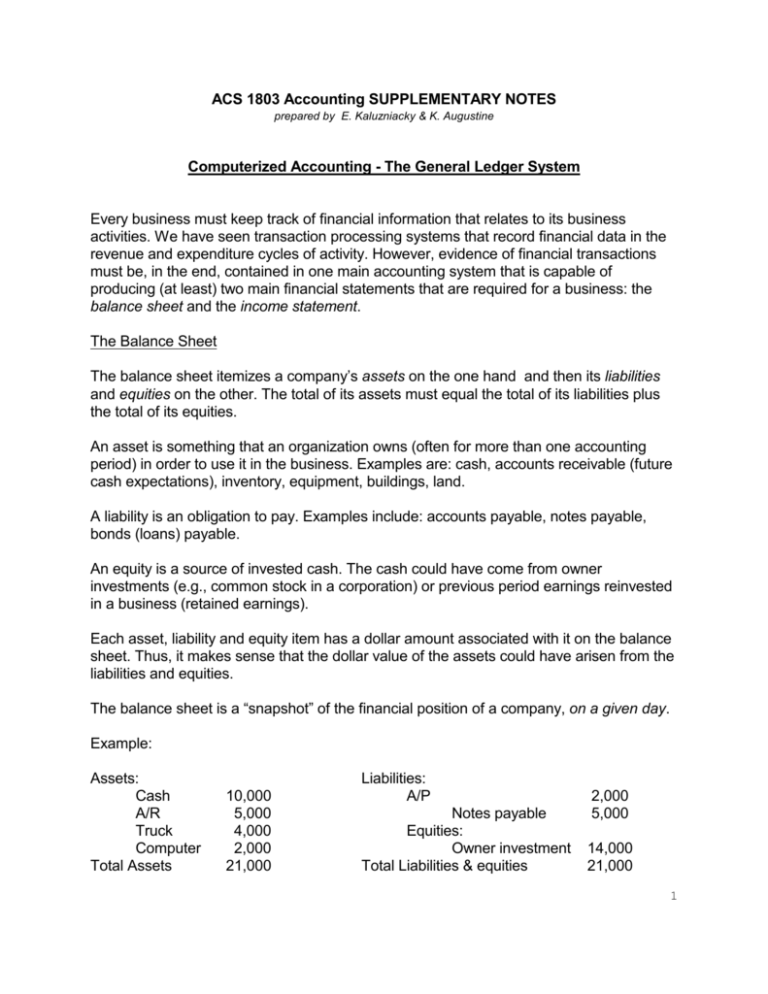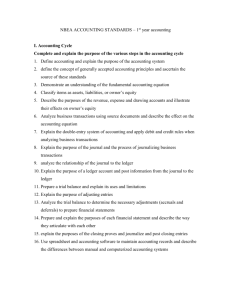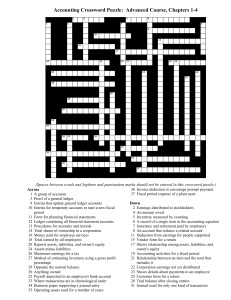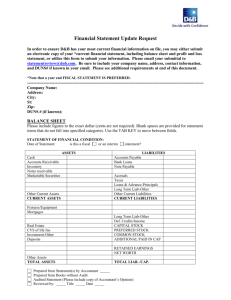ACS 1803 Accounting SUPPLEMENTARY NOTES Computerized
advertisement

ACS 1803 Accounting SUPPLEMENTARY NOTES prepared by E. Kaluzniacky & K. Augustine Computerized Accounting - The General Ledger System Every business must keep track of financial information that relates to its business activities. We have seen transaction processing systems that record financial data in the revenue and expenditure cycles of activity. However, evidence of financial transactions must be, in the end, contained in one main accounting system that is capable of producing (at least) two main financial statements that are required for a business: the balance sheet and the income statement. The Balance Sheet The balance sheet itemizes a company’s assets on the one hand and then its liabilities and equities on the other. The total of its assets must equal the total of its liabilities plus the total of its equities. An asset is something that an organization owns (often for more than one accounting period) in order to use it in the business. Examples are: cash, accounts receivable (future cash expectations), inventory, equipment, buildings, land. A liability is an obligation to pay. Examples include: accounts payable, notes payable, bonds (loans) payable. An equity is a source of invested cash. The cash could have come from owner investments (e.g., common stock in a corporation) or previous period earnings reinvested in a business (retained earnings). Each asset, liability and equity item has a dollar amount associated with it on the balance sheet. Thus, it makes sense that the dollar value of the assets could have arisen from the liabilities and equities. The balance sheet is a “snapshot” of the financial position of a company, on a given day. Example: Assets: Cash A/R Truck Computer Total Assets 10,000 5,000 4,000 2,000 21,000 Liabilities: A/P Notes payable Equities: Owner investment Total Liabilities & equities 2,000 5,000 14,000 21,000 1 Balance Sheet equation: Assets = Liabilities + Equities why? The Balance Sheet is a report that shows what the company owns (Assets) and how it got the money for what it owns (Liabilities i.e. borrowing/ owing) plus Stockholders’ Equity (i.e. Investments, Retained Earnings). The Income Statement: This is a financial “report card” for the business for a period of time (e.g., a year). It lists all revenues and then expenses that were incurred to generate these revenues. Example: Income Statement For year ended Dec. 31, 2007 Sales revenues Rental Revenues 200,000 50,000 Total Revenues Cost of Goods Sold Administrative and Operating Expenses 250,000 120,000 40,000 Total Expenses 160,000 Net Income (before taxes) $90,000 A special “bookkeeping system” is set up in order to be able to produce the above two statements. Such a system is called the General Ledger System. All the revenue and expense account subsystems along with the General Ledger System to which they are connected make up an organization’s Accounting Information System (AIS) (see diagram). 2 3 This is the basic computer support a business organization would have. It involves computer systems supporting revenue and expenditure activities and the basic accounting system necessary to produce financial statements. Computerized Accounting Systems A computerized General Ledger may operate on its own, with no connections to any subsystems; it may be (installed) on its own, but connected to other subsystems such as Order Entry, Accounts Receivable, etc., which are also installed as separate modules; or, we might have a G/L system which is internally integrated with the other closely related subsystems. In the last case, the entire, integrated system is installed at once. Two very popular computerized accounting systems are SAGE 50 (formally Simply Accounting for Windows) and SAGE 300 (formally ACCPAC). SAGE 50 This is an integrated accounting package for small to medium businesses, usually with only one division. Because it is smaller, and relatively inexpensive, it is an integrated package with a General Ledger, Order Entry (basic), A/R, Invoicing, and also Purchasing, A/P, Inventory, and Payroll. The G/L is connected to the other subsystems through "integration accounts". There is a summary account (or several) in the G/L corresponding to detailed records in each subsidiary system. For example, one controlling (integration) account called "Accounts Receivable" in the G/L summarizes all the detailed receivables records in the A/R subsystem. SAGE 300 This is usually for mid to larger sized businesses. The General Ledger System stands on its own. One can also purchase an Accounts Receivable System, and Accounts Payable System, and Inventory System etc.. One can connect them all, to create an integrated system. 4 Using Accounting Software There are two main preparatory steps in using accounting software after it is removed from the box (on a CD). 1. Installing the system: (a computing function). Copying the software to the computer’s hard disk and getting it ready to run. 2. Initializing the system: (an accounting function). Entering specifics on the Company into the system so as to make it ready for day-to day use. This would involve: entering particulars on the Company (e.g. name address) and most importantly, identifying each account (card) by name and by code number for all the Company’s assets, liabilities, equities, revenues, and expenses. The latter is called establishing the Chart of Accounts. Then, the system balances would have to be entered for each account (unless the business is starting ‘from scratch’ on the date of initialization).. If the General Ledger is to be connected to other subsystems, the current status of receivables, payables, inventory, etc, will have top be entered into such systems. Note: when a business says it has a “computerized accounting system”, it may be talking of only the computerized General Ledger or an integrated Accounting Information System (AIS), with the General Ledger at the centre (see diagram above). Also, a General Ledger system will produce many more reports than the Balance Sheet and the Income Statement. Some will be internal reports and may provide extra insight for managers. A good GL system would also have an easy-to-use report generator so that a user could design new and sometimes unplanned reports based on the detailed data that the system stores. Besides SAGE 50 and SAGE 300, common accounting software is QuickBooks (smaller) and [Great Plains] Microsoft Dynamics, which has grown from accounting software to more comprehensive managerial support. See demonstration and overview of SAGE 300 accounting and ERP software. ****** 5





